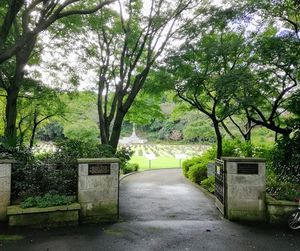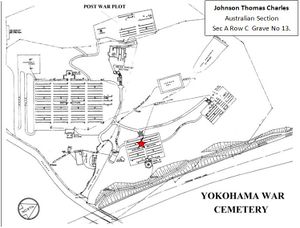Difference between revisions of "Thomas Charles Johnson"
From Our Contribution
| Line 90: | Line 90: | ||
<div><ul> | <div><ul> | ||
<li style="display: inline-block;">[[File:Yokohama_AWar_Cemetery.jpg|thumb|none||Yokohama War Cemetery entry gates]] </li> | <li style="display: inline-block;">[[File:Yokohama_AWar_Cemetery.jpg|thumb|none||Yokohama War Cemetery entry gates]] </li> | ||
| − | <li style="display: inline-block;"> [[File: | + | <li style="display: inline-block;"> [[File:Johnson_Thomas_Charles_grave_site.jpg.jpg|thumb|none||Tom's Grave Site]] </li> |
</ul></div> | </ul></div> | ||
Revision as of 03:05, 18 September 2019
 | |
| Personal Information | |
|---|---|
| Date of Birth | 21 Apr 1919 |
| Place of Birth | Subiaco, Western Australia |
| Death | 13 Jul 1945 |
| Place of Death | Tokyo, Japan |
| Age at Enlistment | 1 years, 11 months |
| Description | 5'7" (1.70m) tall ; ; fresh complexion ; green eyes ; brown hair ; birth mark on his back |
| Occupation | Farmhand |
| Religion | church of England |
| Address | Armadale, Western Australia |
| Next of Kin | Wife , Mrs Olive Catherine Johnson |
| Military Information | |
| Reg Number | 21945 |
| Date of Enlistment | 7 Apr 1938 |
| Rank | Petty Officer |
| Unit/Formation | HMAS Perth |
| Military Movement | |
| 1st Departure from Australia | |
| Journey Dates | 1 Sep 1939 ‒ 9 Apr 1940 |
| Transport Details | HMAS Australia |
| 2nd Departure from Australia | |
| Journey Dates | 4 Oct 1941 ‒ 1 Mar 1942 |
| Transport Details | HMAS Perth |
| Post War Details | |
| Fate |
POW Sunda Strait Killed during US Bombing raid over Tokyo 13 Jul 1945. |
| Monument(s) | Armadale War Memorial |
| Australian War Memorial | Australian War Memorial |
| Medals |
1939-45 Star Pacific Star Defence Medal War Medal 1939-45 Australian Service Medal 1939-45 |
Pre War
Tom enlisted in 1938 for 12 year, entering HMAS Cerberus V (Fremantle Reserve Training Centre) as an Ordinary Seaman on 7 Apr 1938, and after some basic training he was posted to HMAS Vampire for sea training from 29 Sep until 20 Oct 1938. A further period of training was followed by a posting to HMAS Moresby a Survey Sloop then undertaking surveys of waters between Australia and Papua New Guinea. After nearly 7 months on the Moresby he transferred to HMAS Penguin in Sydney and two days later was posted (1 Sep 1939) to HMAS Australia, a County Class Heavy Cruiser that was brought out of reserve with the war declaration.
War Service
As a member of HMAS Australia's crew at the outset of war He helped with her re-commissioning, and was promoted Able Seaman on 16 Dec 1939. Until he left the Australia it served in Australian waters, but as she transferred to convoy duties in the Indian Ocean, he returned to shore duties at HMAS Penguin in Sydney from 10 Apr until 31 Jul 1940, and then HMAS Melville in Darwin from 1 Aug 1940 until 18 Aug 1941. While in Darwin he was promoted to Acting Leading Seaman on 1 Apr 1941. On 2 Apr 1941 Tom was granted his first Good Conduct Badge.
On 19 Aug 1941 he returned to Sydney, based at HMAS Kuttabul on Garden Island and on 4 Oct 1941 he was posted to HMAS Perth a modified Leander Class Light Cruiser, then undergoing a refit at Garden island. He had been promoted 3 days earlier to Acting Petty officer Signals, and he was to remain with HMAS Perth until it was sunk by enemy gunfire in the Sunda Strait. Refit completed, the Perth undertook exercises before sailing to Auckland in December 1941. She also visited New Caledonia and New Guinea. On 14 Feb 1942 the Perth sailed for Java, arriving at Tanjong Priok (Port for Batavia) on 14 Feb 1942. During 14 and 15 Feb she was attacked by Japanese aircraft without damage, and she sailed on 25 Feb 1942 , accompanied by four Royal navy ships for Surabaja, and from there, in the company of four Cruisers, HMNS De Ruyter, HMNS Java, US Houston and HMS Exeter, and nine destroyers, two Dutch, three British and four American, she sailed the next day along the north coat of Madura Island.
During the night of 27-28 February 1942 they were engaged by Japanese forces in what was to be known as the Battle of the Java Sea. Five allied ships were lost in the battle. Peth and Houston returned to Tanjong Priok for fuel and ammunition the next morning, but were unable to obtain either, and were then ordered to sail through the Sunda Strait to Tjilatjap. After they sailed they received intelligence that a Japanese invasion force was to their north east, but was calculated not to cause them any trouble. However a flotilla of Japanese destroyers acting as a screen for the invasion ran into the 'Perth and Houston and a battel followed, with the first hit on Perth occurring 34 minutes before midnight. Soon after midnight she was struck by two torpedos leading to the order to abandon ship. Two more torpedoes struck her and she sank around 12:35am on 1 Mar 1942. The Houston was sunk shortly afterwards, but between the two of them they had also accounted for four Japanese Transport ships. Of the 681 men aboard Perth, 385 survived, Tom being one of them. Four men who made it ashore without being captured subsequently dies as did another 106 as POWs.
Tom appears to have been kept on Java at what was known as Bicycle Camp as a POW before travelling to Singapore in early 1945 to be transported to Japan as slave labour.
The Bicycle Camp was initially shared with Dutch and British POWs and US naval personnel who had survived the sinking of the USS Houston at the same time as the Perth. In mid May 1942, however, the British and Dutch troops (excluding senior British officers) were moved, making room for Australians previously held in Glodok gaol and a congested Chinese school in Batavia, and a further group of Americans. From early August also some of the 2/40th Battalion captured on Timor arrived at the Bicycle Camp. Although conditions across Java varied considerably, on the whole they were far better than what the POWs would experience later in the war. The accommodation was often substantial: for example, large brick barracks huts at the Bicycle Camp. The supply of food was also reasonably good, since trade with the local community was permitted and well-stocked canteens operated inside the camps. The manual labour demanded of the troops was also not onerous: cutting grass, moving stores, cleaning streets, repairing cars, etc.
Yet since the daily caloric intake was inadequate, by mid 1942 many POWs were showing symptoms of malnutrition, such as beri beri, pellagra and scrotal dermatitis. The Japanese also regularly slapped and beat POWs for minor offences, executed several who tried to escape and subjected Allied officers to often brutal interrogation in an effort to extract intelligence. In September the Japanese announced that a large scale movement of troops from Java was planned 'to a better land where food would be available'. The first contingents left the Bicycle Camp in early October leaving only senior officers there.
Some Australians remained on Java where their numbers were increased by further arrivals of the 2/40th Battalion from Timor. In the months that followed they moved between camps—Makasura, Tanjong Priok, the Bicycle Camp and Glodok gaol—which they shared with POWs of other nationalities. Early in 1944 most POWs (including some 400 Australians) were concentrated in the Batavia area though some were employed at Adjick and about 70 were sent to Serang. In October most of the officers were concentrated at Bandung. Then in January 1945 many of the Australians remaining on Java were transferred to Singapore, some occupying the River Valley camp.[1]Ex-POWs rescued by US Submarines after the sinking of the Rakuyo Maru state that Tom was aboard the vessel when it left Singapore for Japan before being sunk in the South China Sea by the American submarine on 26 Jan 1945. Authorities were advised that he had survived and was in a POW camp in Tokyo. However, it appears that he was subsequently killed during an American air raid on Tokyo on 13 Jul 1945. Buried in a USAF Mausoleum in Yokahama on 30 Nov 1945.
Notes
External Links
[[Category:]] [[Category:]]

